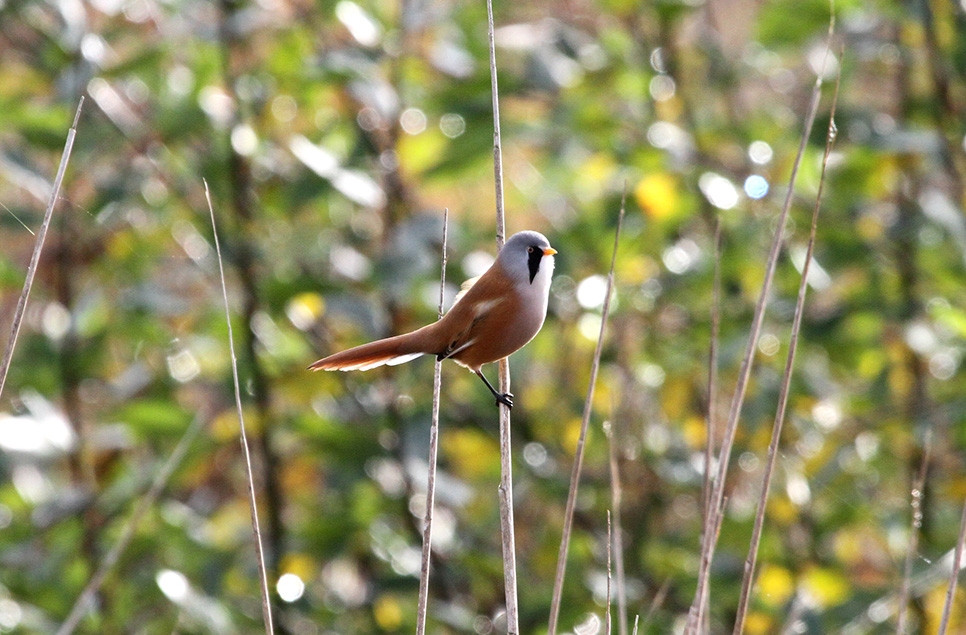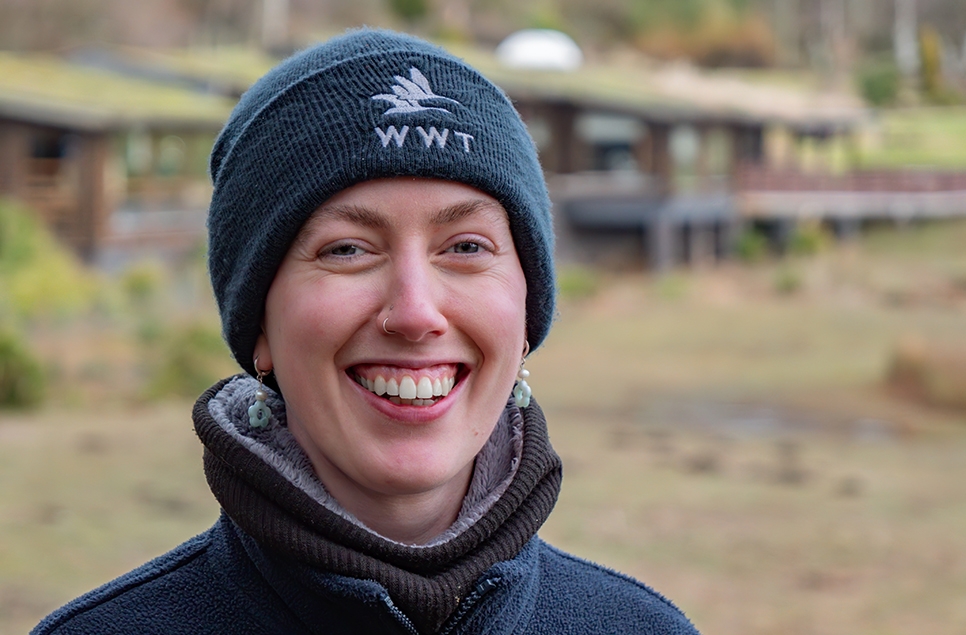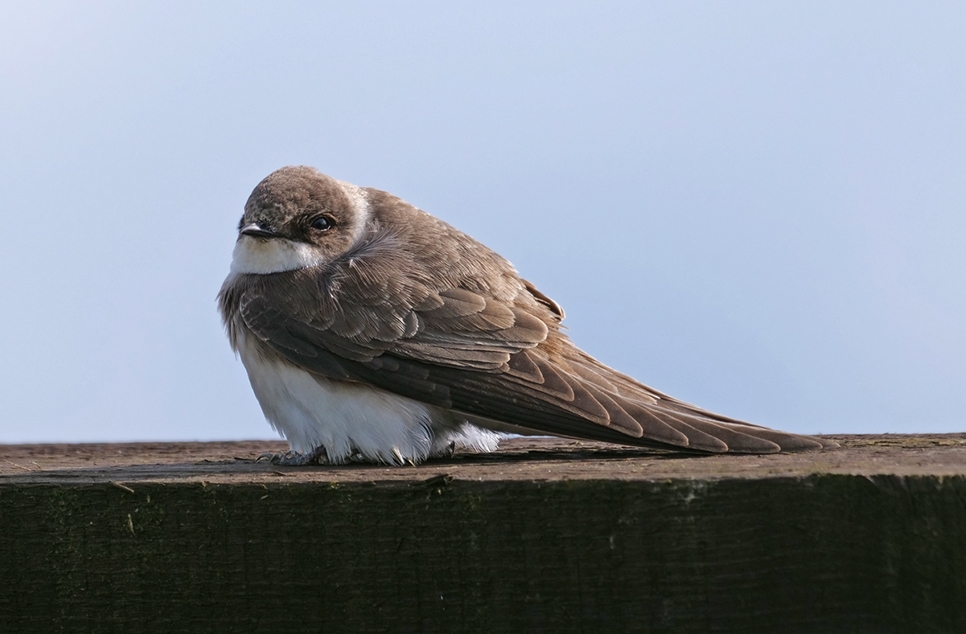Red-listed willow tit breed on our reserve
Seven red-listed willow tit – the UK’s fastest declining resident bird species – have successfully hatched and fledged at WWT Washington Wetland Centre.
The young birds, which left the nest in May, are the offspring of an adult willow tit pair, which were ringed on our reserve last winter as part of an ongoing species recovery research project involving WWT Washington, Newcastle University and the British Trust for Ornithology (BTO).
Wardens had been tracking the movements of the male and female (below) as they explored potential nesting spots across our 100-acre site in early spring, and were delighted when they finally began excavating an old tree stump.
The team quickly set up a camera at the nesting chamber and were rewarded with footage of eight willow tit eggs in the nest – seven of which went on to hatch and fledge.

Other aims include trying to estimate the current local population size, identifying key existing nest sites and establishing new ones, determining the reasons behind nest failure and gauging the abundance of nearby competitor species.
WWT Washington reserve warden Andrew Diamond, part of the team working on the project on the ground, said: “We managed to ring three adult willow tit last winter during a public ringing session, which was part of our ongoing willow tit conservation project.
“Two of those birds – with red-over-white (R/W) and red-over-yellow (R/Y) colour rings – were then captured together by our trail cameras checking out potential nesting sites.
“From the eight eggs laid, seven successfully hatched around May 12 and they all went on to fledge on the morning of May 29, after seventeen days of being looked after by mam.”
One of the keys to the project’s success so far has been its Citizen Science element, with the North East public reporting sightings of elusive willow tit both on site at WWT Washington and in the surrounding area.
Andrew added: “Before the project began, we already knew we had a small population of willow tit here on the reserve and we manage our wet woodlands and other habitats to encourage them to stay.
“But now, thanks to our visitors and members supplying us with sightings data – as well as the wider project team’s help with monitoring and analysing camera footage – we’re starting to build a much better picture of that population and have been able to identify some key willow tit hot spots on site.
“Closely observing the willow tits going about their business through the breeding season has given us some invaluable knowledge that we can use going forward whilst developing willow tit habitat.
“We have realised that we have great tracts of foraging areas throughout our reserve, but not so many areas where willow tit would feel comfortable and secure enough to attempt raising their young.
“Now that we have witnessed an extremely successful willow tit union, leading to the subsequent fledging of a full brood of chicks, we know a little bit more about how we can structure habitat to be potential nest sites for our resident red-listed little wonder.”
The project is also trialling a number of new bespoke nest box designs – both for willow tit and other competitor species – to see if they have an impact on willow tit nesting success.

“It has been a really exciting part of my placement to get involved with the willow tit project,” she said.
“A big part of this has been building the willow tit boxes and throughout the winter, we would spend our Sundays in the workshop alongside our hard-working volunteering group, allowing us to learn as we go.
“Using knowledge about areas that are preferable to willow tits, as well as our own sightings, we put out many of our boxes in strategic places across site.
“These were then checked and monitored with camera traps, and seeing some interest from willow tits in the boxes we built over the following months was very rewarding for both me and the volunteers.”
Willow tits – did you know?
- The British willow tit is the UK’s fastest declining resident bird species.
- It is already extinct across much of southern England and is now rarer than the southern white rhino.
- Since 1995, it has suffered an 85% decline, with the number of breeding pairs dropping from 23,000 to just 3,500.
- This is believed to be due to habitat loss; nest hole competition from other birds, such as blue tit, and nest predation from great-spotted woodpecker.
Citizen Science data collection – how you can take part
For the project team to learn more about the local willow tit population currently, a picture must be built about their movements and activity across both WWT Washington’s site and the surrounding area.
The public can inform this by sharing details including the date, time and location of any willow tit sightings, as well as the number of birds seen and what they were doing, e.g. feeding, flying, resting, preening.
“We're asking the public to be our eyes and ears around our centre, the reserve and also the surrounding area”, said WWT Washington’s reserve manager John Gowland.
“We currently provide a variety of bespoke nesting habitat options for willow tits and other standard nest box options for other species, but don’t have any way of knowing if these boxes or the provision of other bird feeding areas is impacting on willow tit success.
“Data collected during the project will help us to design and test both current and new nest boxes, as well as other nest opportunities and feeding techniques.
“If you spot a willow tit while on our site or in the neighbouring area, please complete a form at the centre – available at reception and Hawthorn Wood Hide – and report it to the team during your visit.
“Alternatively, please let us know directly by emailing the details to info.washington@wwt.org.uk or contacting us via social media @wwtwashington
>> How to identify a willow tit <<
Willow tit Q&A with reserve warden Andrew Diamond...

How did we know the willow tit were going to nest?
We managed to ring three willow tit last winter and it was two of those birds – with ‘red-over-white’ (R/W) and ‘red-over-yellow’ (R/Y) colour rings – which were captured together by our trail cameras checking out potential nesting sites.
They would take it in turns to have a go chipping away at the tree, maybe to determine the suitability of the wood or maybe they were warming up their neck muscles for the main job ahead.
Which nest box did they end up using?
After providing several styles of bespoke willow tit nest boxes – a few of which they began excavating – the pair eventually chose to use a standing, decaying willow stump, concealed deep with a hawthorn thicket entwined through with bramble and rose.They chipped out a small oval entrance measuring 30mm x 35mm and then excavated their nest chamber to approximately 25cm deep by 8cm in diameter, which they lined with a thick layer of feathers to complete the job.
How long did the eggs take to hatch?
Willow tits typically incubate their eggs over a period of 13-15 days and there were 8 eggs laid by R/Y.During the incubation period R/W was seen to be bringing food for R/Y.
How many young fledged and how long does it take from hatching?
From the eight eggs laid, seven successfully hatched around about May 12 and they all went on to fledge on the morning of May 29 after seventeen days being looked after by mam.R/Y was the main provider for her rapidly growing chicks, bringing them a ready supply of fat, juicy caterpillars.R/W took little part in the feeding of the chicks, although he was regularly captured by trail cameras at different parts of the site.An un-ringed willow tit was also observed to be assisting R/Y with feeding the chicks.
Where would be best to see them now?
Willow tits are known to skulk around within thick undergrowth, so they can be quite difficult to see clearly.I would recommend that any birds seen in such circumstances are worth a closer look and by being extra vigilant and rigorously checking on all these small birds, you may get to see a willow tit within a natural setting.Our wildlife ponds offer good willow tit foraging opportunities and Wader Lake footpath is an excellent highway for willow tit moving from one side of the site to another.Willow tit will regularly visit our feeding stations at Hawthorn Wood hide and the Look Out, so these locations are great places where you can wait for willow tit to come to you.
What does this breeding success mean for the species on our site?
Being given the means to closely observe the willow tit going about its business through the breeding season has given us some invaluable knowledge that we can use going forward whilst developing willow tit habitat.We have realised that we have great tracts of foraging areas throughout our reserve but not so many areas were willow tit would feel comfortable and secure enough to attempt raising their young.Now that we have witnessed an extremely successful willow tit union, leading to the subsequent fledging of a full brood of chicks, we know a little bit more about how we can structure habitat to be potential nest sites for our resident red-listed little wonder.
Ready to visit?
If you've been inspired to explore Washington Wetland Centre and see willow tit for yourself, find out more and plan your visit online.



